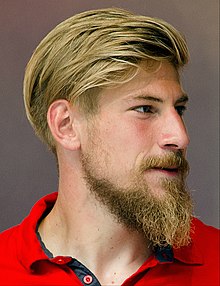Our website is made possible by displaying online advertisements to our visitors.
Please consider supporting us by disabling your ad blocker.
Blond

Blond (MASC) or blonde (FEM), also referred to as fair hair, is a human hair color characterized by low levels of eumelanin, the dark pigment. The resultant visible hue depends on various factors, but always has some yellowish color. The color can be from the very pale blond (caused by a patchy, scarce distribution of pigment) to reddish "strawberry" blond or golden-brownish ("sandy") blond colors (the latter with more eumelanin). Occasionally, the state of being blond, and specifically the occurrence of blond traits in a predominantly dark or colored population are referred to as blondism.[1]
Because hair color tends to darken with age, natural blond hair is significantly less common in adulthood. Naturally-occurring blond hair is primarily found in people living in or descended from people who lived in Northern Europe, and may have evolved alongside the development of light skin that enables more efficient synthesis of vitamin D, due to northern Europe's lower levels of sunlight. Blond hair has also developed in other populations, although it is usually not as common, and can be found among the native populations of the Solomon Islands, Vanuatu, and Fiji; among the Berbers of North Africa; and among some Asian people.
In Western culture, blonde hair has long been associated with beauty and vitality. Aphrodite, the ancient Greek goddess of love and beauty, was described as having blonde hair. In the Greco-Roman world, blonde hair was frequently associated with prostitutes, who dyed their hair using saffron dyes in order to attract more customers. The Greeks stereotyped Thracians and slaves as blond and the Romans associated blondness with the Celts and the Germanic peoples to the north. In the ancient Greek world, Iliad presented the mythological hero Achilles as what was then the ideal male warrior: handsome, tall, strong, and blond.[2] In Western Europe during the Middle Ages, long and blonde hair was idealized as the paragon of female beauty. Sif, the wife of Thor in Norse mythology, and Iseult, the Celtic-origin legendary heroine, were both significantly portrayed as blonde. In contemporary Western culture, blonde women are often stereotyped as beautiful, but unintelligent.
- ^ "blondism". Merriam-Webster.com Dictionary. Merriam-Webster. Retrieved 2 January 2021.
- ^ Nolasco, Sócrates (9 June 2017). From Tarzan to Homer Simpson: Education and the Male Violence of the West. Springer. p. 143. ISBN 978-94-6351-035-6. Archived from the original on 4 April 2023. Retrieved 27 July 2022.
Previous Page Next Page


